
Welcome back to Part 7 of our $20k Homestead series! In this episode, we cover the installation of our septic system! Hooray for poopers! In case you missed them, links to Parts 1 through 6 are at the end of this post.

Options and Alternatives
Our property is out of range of any city water or sewer connections. This may or may not be the case with your land, so be sure to check.
Not just Cities...
I used to think water & sewer connections were only within the city limits (as they are here, where we live). However, when a family member moved to another state we were surprised to see they had county water, and some areas had county sewer running to rural land! So check your land or prospective land if there are hookups. It could save you a lot of money!
Cost aside, we were happier to have our own water and septic systems. This allows us to be more independent and a few clicks toward off-grid. Additionally, if something happens to the city water or sewer system, we're unaffected!
I read through our county regulations regarding alternatives to a septic system. Our county allows the use of composting toilets, but not gray water recycling systems. They still require all gray water be put into a septic system, so this killed any ideas of an alternative way of treating our waste on-site for a lower cost. Fooey... traditional septic system it is!

Easy Quote & Job!
After our headaches with getting a house mover, we were concerned about running into the same issue with our septic installer. However, the same company that ended up moving our home, recommended an installer who was great to work with and fast! The cost of the septic system was $3,500. This included installation, inspections, required cleanouts, and running a "stub out" pipe under the home to connect the house to.

2 Bedroom vs. 3 Bedroom
Our home only has two bedrooms, which is the metric in which septic systems are designed in our area. We thought of putting in a larger three bedroom septic system to add some future-proofing, but the added cost ($800) and lack of need (there is only 4 of us) made us stick with the two bedroom. I asked our septic installer the cost difference between getting it now versus later, and it will be $200 more to do it later. He talked that our septic system and soil composition was such that it wouldn't be an issue with 6 people, unless someone did something dumb, so we feel confident in our decision.

Septic Permit & Plans
As discussed in Part 3 of our series, we had to get a complete soil test and septic permit from the county at a cost of $250. From this permit and test, our septic system was designed and given to us to build from. Our county requires licensed installers for all septic components.

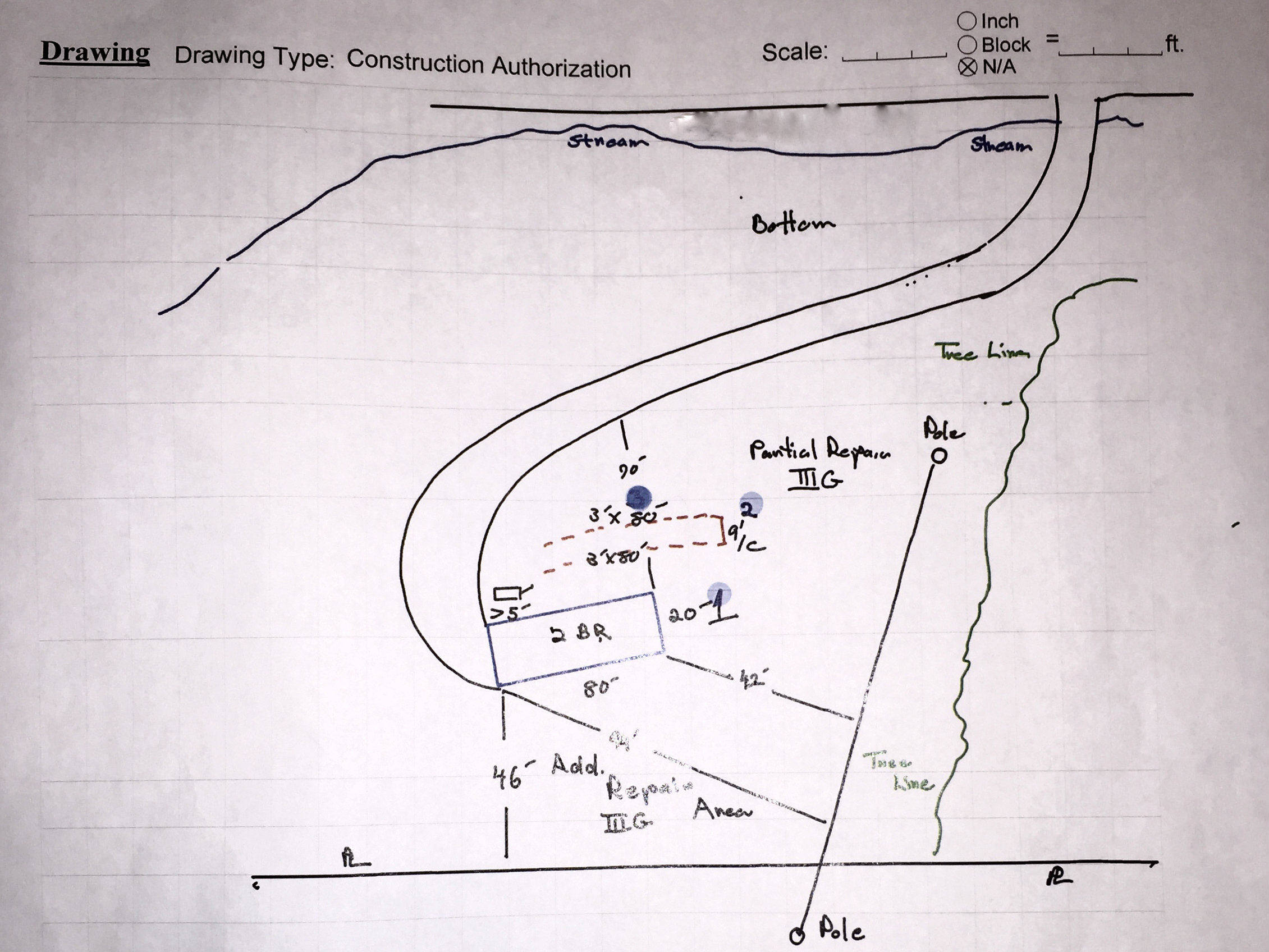

Installation
I know nothing about septic systems, except from what Google tells me, but I was happy to see the components installed on our land were the same as what I read were good--a ribbed poly tank and black poly tunnels for the drain field instead of gravel and pipes wrapped with styrofoam.
The installation of the septic system was done in two days. One day to dig and install the components, and one day for county inspection and covering it over with soil.

The Photos
What? No video?
Sorry, not this time...
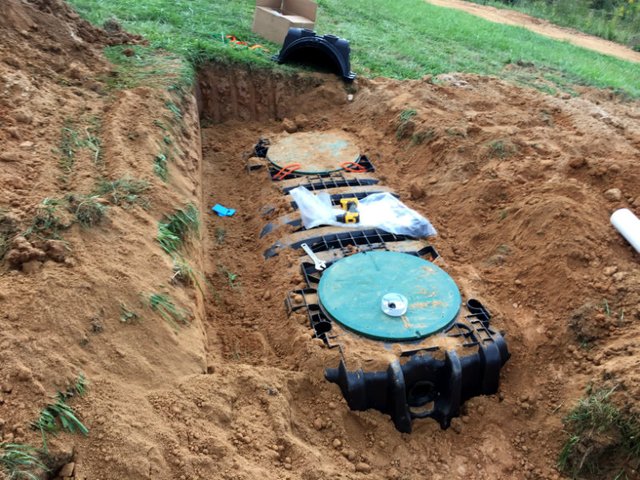
The septic tank mostly back-filled. The green circles are the manhole covers.
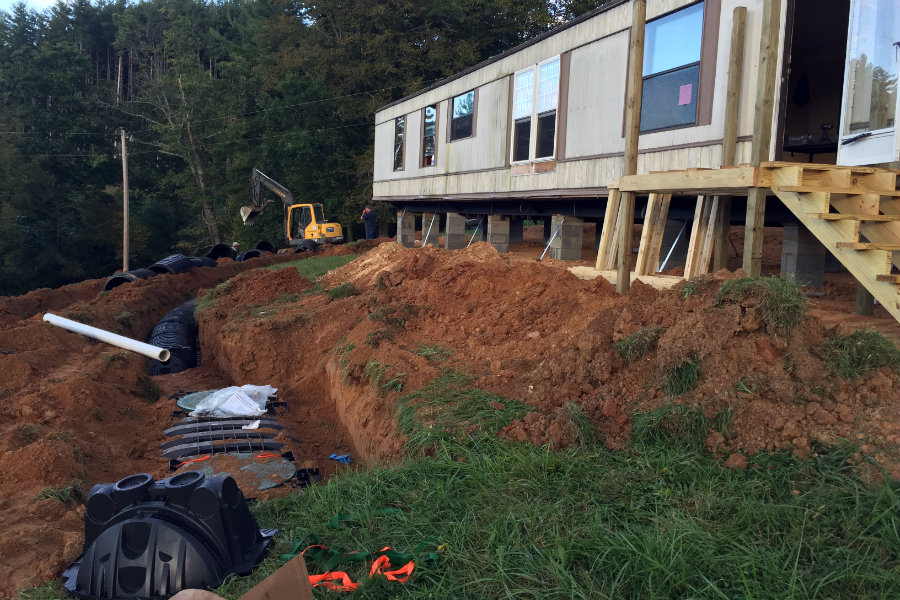
Taken as the septic crew were digging the second drain field line. Also works as a future reference/reminder for me of where the tank and lines are. We have plans to build a large covered front porch on the house.
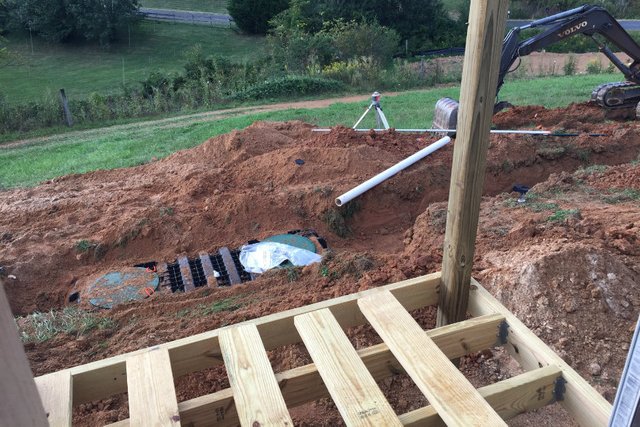
View out the front door.
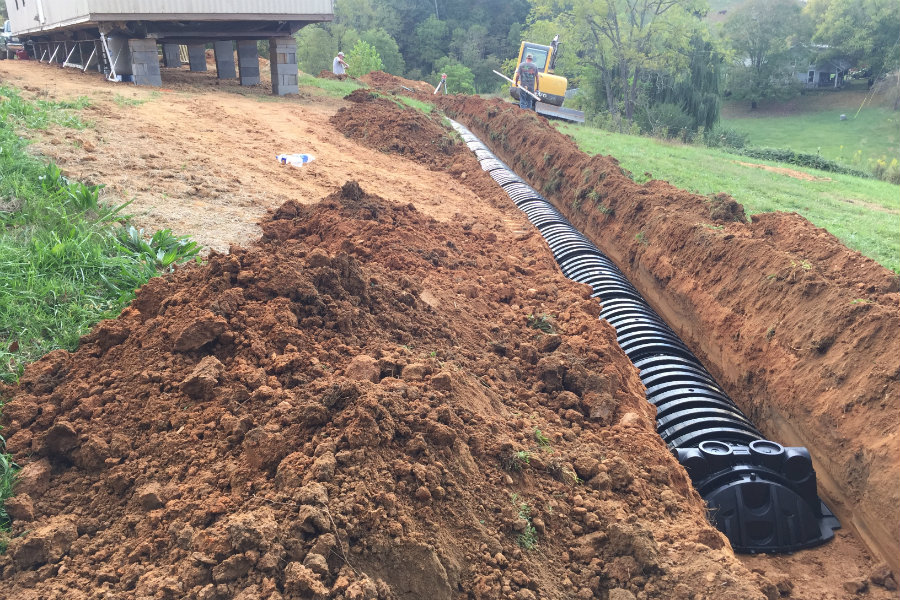
The upper drain field line. Also serves as a future reference photo.
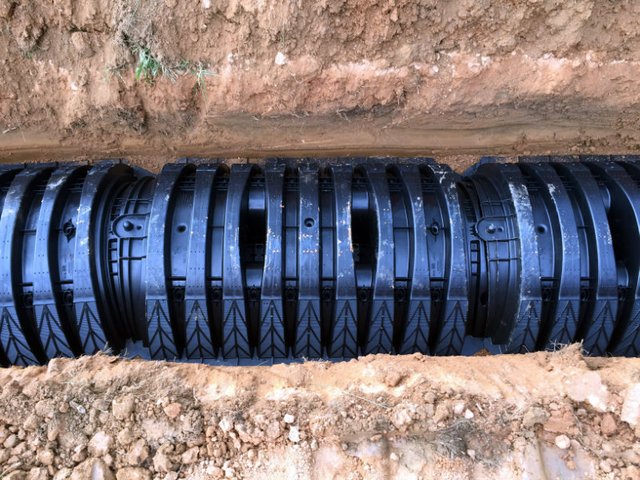
Closer view of the drain field pipe/tunnel.
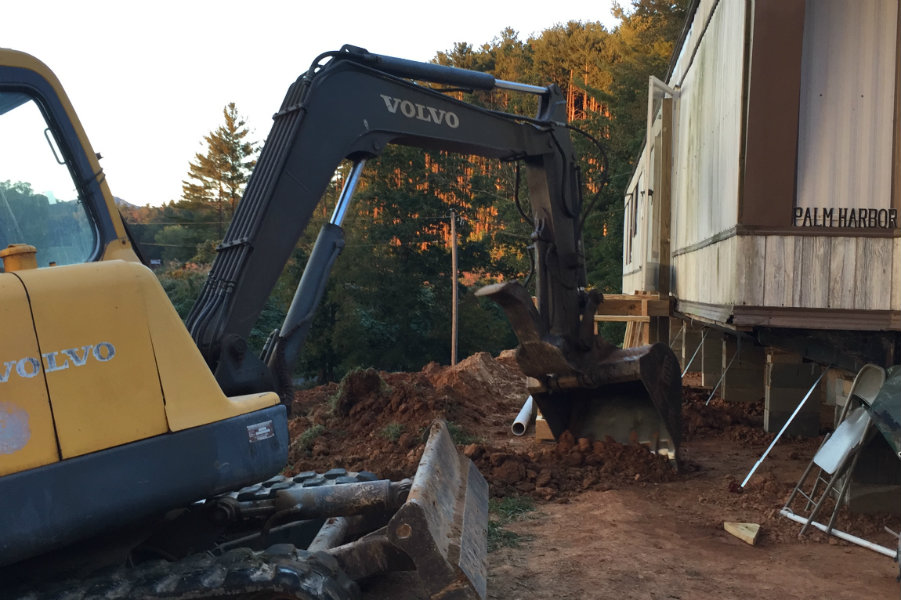
Crew digging the small trench for the pipe that runs from the septic tank to under the home.
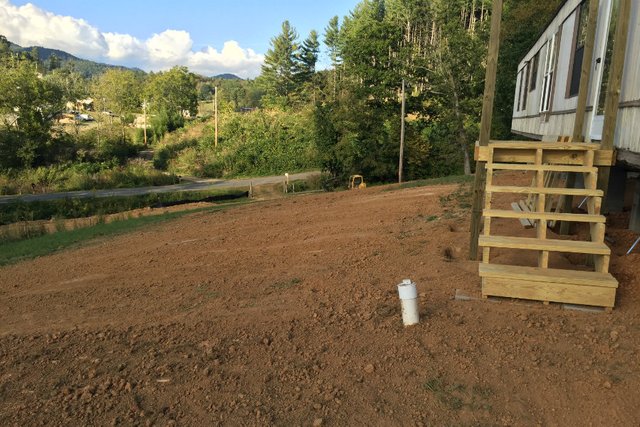
View of the finished product. The cleanout pipe was later trimmed closer to the ground.

View from the front yard looking up at the home.

Coming Up Next...
Trenching for Power Lines
Electrical Hookup
Porch Builds
DIY Land Grading
And More!
Be sure to follow us so you don't miss our next update. Also upvote and resteem, it helps greatly!
Thanks
@greenacrehome
Catch up on the previous posts here:
Part 1, Part 2, Part 3, Part 4, Part 5, and Part 6

Congratulations @greenacrehome! You have completed some achievement on Steemit and have been rewarded with new badge(s) :
Click on any badge to view your own Board of Honor on SteemitBoard.
For more information about SteemitBoard, click here
If you no longer want to receive notifications, reply to this comment with the word
STOPDownvoting a post can decrease pending rewards and make it less visible. Common reasons:
Submit
Making the dreams happen! Resteemit for others to see it does happen!
Downvoting a post can decrease pending rewards and make it less visible. Common reasons:
Submit
Thank you very much!!!
Downvoting a post can decrease pending rewards and make it less visible. Common reasons:
Submit
Part 8 just posted: https://steemit.com/diy/@greenacrehome/the-usd20k-homestead-part-8-the-grid
Downvoting a post can decrease pending rewards and make it less visible. Common reasons:
Submit
we'll forgive you for no video this time but don't let it happen again ;-)
Downvoting a post can decrease pending rewards and make it less visible. Common reasons:
Submit
Hahahaa!!! I'll try my best. :)
Downvoting a post can decrease pending rewards and make it less visible. Common reasons:
Submit
Part 8 just posted: https://steemit.com/diy/@greenacrehome/the-usd20k-homestead-part-8-the-grid
Downvoting a post can decrease pending rewards and make it less visible. Common reasons:
Submit
What I like about having our own well and septic is that we can control what goes into it. I never use chemicals for cleaning because I would not want them mixing with our future drinking water. It may not be the cleanest house but the water is great!
We also use a product like Green Pig (a septic tank treatment that will keep your system in proper working order by breaking down the waste... septic tank bacteria break down the organic waste into a liquid form making it easier to flow through the leach lines and back into the earth to be filtered naturally.)
I am enjoying your articles.
Downvoting a post can decrease pending rewards and make it less visible. Common reasons:
Submit
I've never heard of Green Pig, but reading their site, they sound great! Will be picking up some next paycheck. Great to hear you're liking our articles, too! Thanks
Downvoting a post can decrease pending rewards and make it less visible. Common reasons:
Submit
Don't forget to upvote and resteem/reblog posts you like!
Downvoting a post can decrease pending rewards and make it less visible. Common reasons:
Submit
I keep hearing that but I am not sure why. It keeps articles on the trending page for longer?
Downvoting a post can decrease pending rewards and make it less visible. Common reasons:
Submit
No, it helps both the author (me, in this case) and the curator (you, in this case). It's what makes Steemit awesome and how we all make a few coins while interacting. Authors only get paid when people upvote their content. And your curation reward is based partly upon how many other people upvote this post after you. So the sooner you vote, the bigger your reward. Resteeming spreads the viewership of this post to possibly increase the rewards to you and I.
Upvoting and resteeming are core requirements and functions for Steemit to work. :)
Part 8 just posted: https://steemit.com/diy/@greenacrehome/the-usd20k-homestead-part-8-the-grid
Downvoting a post can decrease pending rewards and make it less visible. Common reasons:
Submit
I thank you for your instruction. I just saw your new post so I will go and practice with it.
Downvoting a post can decrease pending rewards and make it less visible. Common reasons:
Submit
looks like it's all coming together! thanks for sharing!
Downvoting a post can decrease pending rewards and make it less visible. Common reasons:
Submit
And thanks for reading and commenting! :-) Part 8 just posted: https://steemit.com/diy/@greenacrehome/the-usd20k-homestead-part-8-the-grid
Downvoting a post can decrease pending rewards and make it less visible. Common reasons:
Submit
Hi,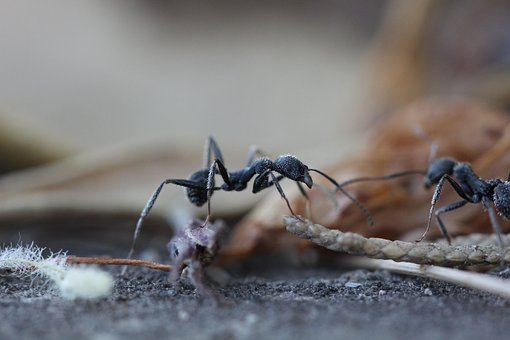
It's good to read your post. I put in a mechanical septic system about 4 years ago. I wanted to let you know that sometimes ants can get in your pump and destroy it. So, it's a good practice to go spray poison inside your pump area to make sure there are no ants in there to break your system.
!
I hope this information helps.
Downvoting a post can decrease pending rewards and make it less visible. Common reasons:
Submit
It is good to know, but thankfully, we do not have a pump in our system! Our free range chickens do good at eating the bugs, but any flares or nests we find get treated accordingly. Thanks for the info!
Downvoting a post can decrease pending rewards and make it less visible. Common reasons:
Submit
Interesting! I haven't seen a drain field tunnel like that before.
Downvoting a post can decrease pending rewards and make it less visible. Common reasons:
Submit
We hadn't either until searching online for designs. Most common, or "old types" are corrugated pipes with styrofoam peanuts around them in gravel trenches. At least in our area. Thanks for reading and commenting!
Downvoting a post can decrease pending rewards and make it less visible. Common reasons:
Submit
This post received a 4.0% upvote from @randowhale thanks to @greenacrehome! For more information, click here!
Downvoting a post can decrease pending rewards and make it less visible. Common reasons:
Submit